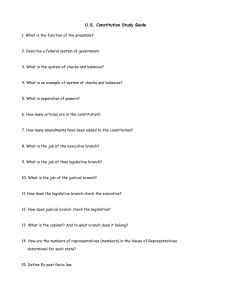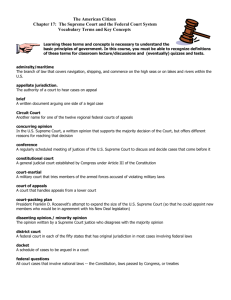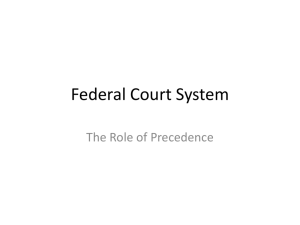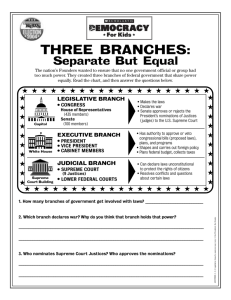the Chief Justice of the United States eight Associate Justices, who
advertisement
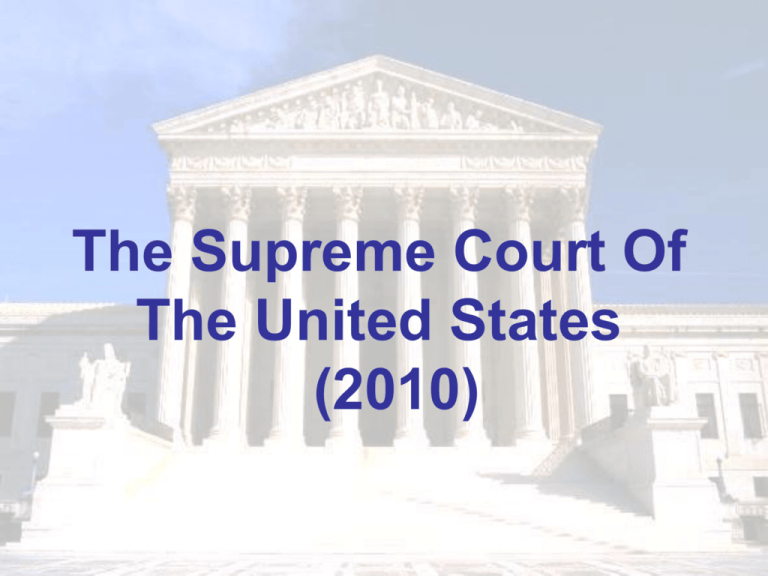
The Supreme Court Of The United States (2010) The Supreme Court of the United States is the highest judicial body n the United States, and leads the federal judiciary. It consists of: he Chief Justice of the United States eight Associate Justices, who are nominated by the President and confirmed with the “advice and consent" (majority vote) of the Senate The Court meets in Washington D.C. in the United States Supreme Court Building. The Supreme Court is primarily an apellate court, but it has original jurisdiction over a small range of cases. History •The earliest Courts under Chief Justices Jay, Rutledge, and Ellsworth (1789– 1801) • Marshall Court (1801–1835) which declared the Court to be the supreme arbiter of the Constitution •The Taney Court (1836–1864) made several important rulings, such as Sheldon v. Sill, which held that while Congress may not limit the subjects the Supreme Court may hear, it may limit the jurisdiction of the lower federal courts • White and Taft Courts (1910–1930) • During the Hughes, Stone, and Vinson Courts (1930–1953), the court gained its own accomodation in 1935 •The Warren Court (1953–1969) made many rulings, sometimes celebrated, sometimes controversial, expanding the application of the Constitution to civil liberties •The Burger Court (1969–1986) ruled the Constitution protected a woman's right to privacy and control over her own body, thus striking down outright abortion bans •The Rehnquist Court (1986–2005) was noted for its revival of the concept of federalism which included restrictions on Congressional power •The Roberts Court (2005–present) began with the confirmation and swearing in of Chief Justice John G. Roberts on September 29, 2005, and is the current presiding court.The Roberts Court is seen as more conservative than the previous court. John Marshall Roger B. Taney White and Taft Courts William H. Rehnquist The Warren Court Warren E. Burger John Glover Roberts, Jr. (born January 27, 1955) is the 17th and current Chief Justice of the United States. He has served since 2005, having been nominated by President George W. Bush after the death of Chief Justice William Rehnquist. He has been described as having a conservative judicial philosophy in his jurisprudence. Appointment and confirmation The Roberts Court, 2009 Article Two of the United States Constitution gives the President power to appoint Justices "by and with the advice and consent of the Senate". Most Presidents nominate candidates who broadly share their ideological views, although a Justice's decisions may end up being contrary to what the nominating President anticipated. Because the Constitution does not set any qualifications for service as a Justice, the President may nominate anyone to serve. However, that person must receive the confirmation of the Senate. Current membership John Paul Stevens (age 90) Ruth Bader Ginsburg (age 77) Clarence Thomas (age 61) John G. Roberts (age 55) Antonin Scalia (age 74) Samuel Alito (age 60) Anthony Kennedy (age 73) Stephen Breyer (age 71) Sonia Sotomayor (age 55) Seniority and seating Many of the internal operations of the Court are organized by the seniority of the Justices; the Chief Justice is considered the most senior member of the Court, regardless of the length of his or her service. The Associate Justices are then ranked by the length of their service. In the official yearly Court photograph, Justices are arranged with the five most senior members sitting in the front row in the same order as they would sit during Court sessions, and the four most junior Justices standing behind them, again in the same order as they would sit during Court sessions. In the Justices' private conferences, the current practice is for Justices to speak and vote in order of seniority from the Chief Justice first to the most junior Associate Justice last. Salary For the year 2010, an Associate Justice is paid $213,900 and the Chief Justice $223,500. Article III of the U.S. Constitution prohibits Congress from reducing the pay for incumbent Supreme Court justices. Judicial leanings While justices do not represent or receive official endorsements from political parties, as is accepted practice in the legislative and executive branches, jurists are informally categorized in legal and political circles as being judicial conservatives, moderates, or liberals. Such leanings, however, refer to legal outlook rather than a political or legislative one. Facilities The Supreme Court first met on 1 February 1790, at the Merchants' Exchange Building in New York City, which then was the national capital Philadelphia became the capital city later in 1790, and the Court followed Congress and the President there, meeting briefly in Independence Hall After Washington, D.C. became the capital in 1800, the Court occupied various spaces in the United States Capitol building until 1935 The present building of the Supreme Court Jurisdiction Section 2 of Article Three of the United States Constitution outlines the jurisdiction of the federal courts of the United States: “The judicial Power shall extend to all Cases, in Law and Equity, arising under this Constitution, the Laws of the United States, and Treaties made, or which shall be made, under their Authority; to all Cases affecting Ambassadors, other public Ministers and Consuls; to all Cases of admiralty and maritime Jurisdiction; to Controversies to which the United States shall be a Party; to Controversies between two or more States; between a State and Citizens of another State; between Citizens of different States; between Citizens of the same State claiming Lands under Grants of different States, and between a State, or the Citizens thereof, and foreign States, Citizens or Subjects.” Criticism Some criticisms leveled at the Supreme Court are: • Judicial activism. The Supreme Court has been criticized for not keeping within Constitutional bounds by engaging in judicial activism. rather than merely interpreting law and exercising judicial restraint. • Federal versus state power. There has been debate throughout American history about the boundary between federal and state power. • Judicial interference in political disputes. • Supreme Court has too much power. This criticism is related to complaints about judicial activism. • Failing to protect individual rights. Information sources: www.wikipedia.org




